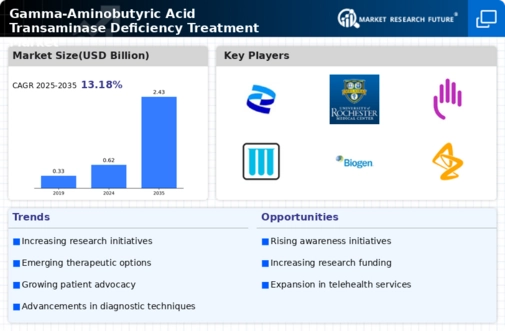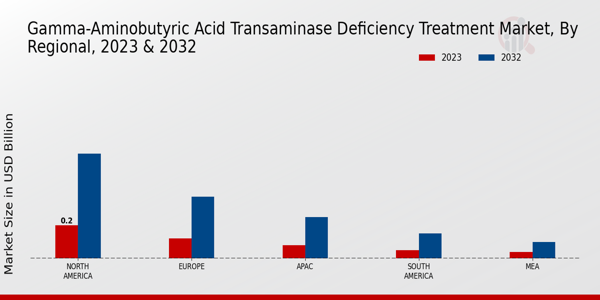Market Growth Projections
The Global Gamma-Aminobutyric Acid Transaminase Deficiency Treatment Market Industry is projected to experience substantial growth over the coming years. With an expected market size of 0.62 USD Billion in 2024, the industry is on track to reach 2.43 USD Billion by 2035. This growth trajectory indicates a compound annual growth rate of 13.24% from 2025 to 2035, driven by various factors including increased awareness, advancements in research, and regulatory support. The market's expansion reflects the rising demand for effective treatments for GABA transaminase deficiency, highlighting the importance of ongoing investment and innovation in this field.
Advancements in Genetic Research
Recent advancements in genetic research are propelling the Global Gamma-Aminobutyric Acid Transaminase Deficiency Treatment Market Industry forward. As scientists uncover the genetic underpinnings of GABA transaminase deficiency, targeted therapies are becoming more feasible. This progress allows for the development of personalized medicine approaches, which may enhance treatment efficacy and patient outcomes. The potential for gene therapy and other innovative treatments is likely to attract investment and research funding, further stimulating market growth. By 2035, the market could expand to 2.43 USD Billion, reflecting the impact of these scientific breakthroughs on treatment options.
Increased Awareness and Diagnosis
The Global Gamma-Aminobutyric Acid Transaminase Deficiency Treatment Market Industry is benefiting from increased awareness and improved diagnostic capabilities. Healthcare professionals are becoming more adept at recognizing the symptoms associated with GABA transaminase deficiency, leading to earlier and more accurate diagnoses. This heightened awareness is crucial, as timely intervention can significantly improve patient outcomes. As more patients are diagnosed, the demand for effective treatments is expected to rise. Consequently, the market is poised for substantial growth, with a projected compound annual growth rate of 13.24% from 2025 to 2035, reflecting the increasing recognition of this condition.
Regulatory Support for Innovative Therapies
Regulatory bodies are increasingly supportive of innovative therapies, which is positively influencing the Global Gamma-Aminobutyric Acid Transaminase Deficiency Treatment Market Industry. Initiatives aimed at expediting the approval process for new treatments are fostering a conducive environment for pharmaceutical companies. This regulatory support is crucial for bringing novel therapies to patients in a timely manner, particularly in areas with high unmet needs. As the industry adapts to these regulatory changes, the potential for market expansion increases. The combination of supportive policies and innovative research may lead to a flourishing market landscape.
Rising Prevalence of Neurological Disorders
The Global Gamma-Aminobutyric Acid Transaminase Deficiency Treatment Market Industry is experiencing growth due to the increasing prevalence of neurological disorders. Conditions such as epilepsy and anxiety disorders, which are often linked to GABA deficiencies, are becoming more common. This trend is particularly evident in urban populations, where lifestyle factors contribute to mental health issues. As awareness of GABA-related conditions rises, the demand for effective treatments is expected to increase significantly. The market is projected to reach 0.62 USD Billion in 2024, indicating a strong need for innovative therapies to address these growing health concerns.
Growing Investment in Pharmaceutical Research
Investment in pharmaceutical research is a key driver of the Global Gamma-Aminobutyric Acid Transaminase Deficiency Treatment Market Industry. Pharmaceutical companies are allocating resources to develop new therapies targeting GABA transaminase deficiency, recognizing the unmet medical needs in this area. This influx of funding is likely to accelerate the pace of clinical trials and bring innovative treatments to market more quickly. As the industry evolves, the introduction of novel therapies may enhance treatment options for patients, thereby expanding the market. The anticipated growth trajectory suggests a robust future for the industry as new products emerge.
























Leave a Comment